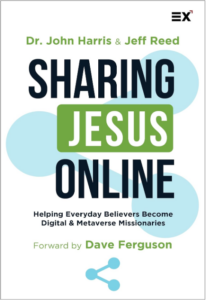Sharing Jesus Online: Helping Everyday Believers Become Digital and Metaverse Missionaries by John Harris and Jeff Reed. Coppell, TX: Exponential, 2023, 161 pages. ISBN 978-1624241123, paperback. ISBN 978-1624241130, epub. Available from Amazon.
Digital spaces are expanding with the onset of new technologies and online platforms. From social media to the metaverse, new people turn to online communities daily. Christians may have many questions about how to navigate these digital spaces and how to practically share Jesus. Dr. John Harris and Jeff Reed’s book, Sharing Jesus Online: Helping Everyday Believers Become Digital and Metaverse Missionaries, provides practical steps to understanding people in digital spaces with a relational approach. Dr. Harris and Reed share about advances in technology and how increased access is opening doors to many people who might not be reached otherwise. While digital spaces can feel expansive and daunting, Dr. Harris and Reed stress that building relationships online is an effective strategy for the proclamation of the gospel.
“It has been said that people don’t care how much you know until they know how much you care.” This common quote rings true for Dr. Harris and Reed’s approach to treating people online as we might build relationships traditionally. People who may be receptive to the gospel are those who see you as interested in getting to know who they are. They advocate that any Christian with digital access has the potential to be a digital missionary. While the online landscape may differ from offline interactions, it doesn’t have to be intimidating.
Dr. Harris and Reed’s foundational framework for initiating gospel conversations is B.L.E.S.S.:
B—Begin with Prayer
- We lean on the Spirit to guide us in approaching new people with whom to share Jesus.
L—Listen
- Listening to others is key to developing trusting relationships in which the gospel can be shared.
E—Enjoy Sharing Experiences
- Shared experiences online will look different from in-person, which means connecting with people where they are, like on social media, gaming, or the metaverse. These platforms lend for relationships to be built such as over content, play, or VR.
S—Serve
- Serving someone digitally has creative possibilities, including sharing knowledge or resources and meeting basic, relational needs.
S—Share Your Jesus Story
- One of the best ways to build relationships towards sharing the gospel message is through your personal testimony of how Jesus changed your life.
The B.L.E.S.S. framework is a flexible set of principles with the goal of helping everyday believers begin sharing about Jesus online. Dr. Harris and Reed hope that this framework will serve as a valuable starting point for Christians who may be unsure of how to start. They provide practical steps to build relationships in digital spaces and how to share about Jesus.
Dr. Harris and Reed begin with their first chapter, “Reimaging the Great Commission,” discussing how digital spaces have opened new opportunities for evangelism. Digital missionaries are using messaging apps like WhatsApp to engage in gospel conversations with thousands of people. People with online access around the world may have their first exposure to the gospel with a digital missionary. Another example is to look at the users of Facebook as the largest “nation” to which Jesus has commanded us to go in the Great Commission. With many active users, there is a large potential for digital evangelism and pioneering work to begin through a large social media platform. Digital evangelism is connecting users across multiple devices, whether they are mobile, desktop, or VR goggle users.
Metaverse technology is on the rise and while relatively new, has much potential to be explored for digital evangelism. It differs from other digital mission fields as users tend to be early adopters. Unlike social networks, users in the metaverse are less likely to already know each other, which opens new opportunities for connection with someone to hear the gospel for the first time. Metaverse churches are also being initiated as new experiences and inviting a new demographic of online users who may be hesitant to join a church in person. New digital communities also represent a shift in culture, which redefines the possibilities of gathering and connection.
While these various online spaces and technologies are exciting, the goal of sharing the gospel still rests on the individual Christian. Dr. Harris and Reed express the desire for any Christian online to take up the ministry of evangelism and discipleship for themselves. Going online to do so is becoming increasingly accessible and necessary!
Through several chapters of the book, Dr. Harris and Reed proceed with basic applications and fears to overcome to take the step to share Jesus online. They address several misconceptions about reaching people, where online platforms have different social dynamics and cultures. They also debunk religious apprehensions about entering digital spaces, so that Christians may be informed in how to navigate it without compromise.
They apply the B.L.E.S.S. framework as a basic example for any Christian to start relationships online. Dr. Harris and Reed express the importance of prayer for all approaches to ministry, even if it is a simple conversation with a new person online.
Active listening online may look different from texting, chat rooms, audio spaces, and other platforms. Social listening, the process of identifying and accessing what is being said about an individual is also key for helping digital missionaries connect with others online. This can be a shared interest or experience, which increases the possibility for direct engagement.
Shared experiences have been some of the most effective methods for Christians to connect with new people. Video and online gaming have invited people to connect globally and have even produced communities and friendships through playing together. Dr. Harris and Reed write, “The anonymity of digital allows for incredibly authentic conversations. Some of the most honest conversations I’ve had with strangers took place while playing video games. Gamers can easily strengthen relationships with other gamers” (p. 93). Likewise, VR spaces, online learning, online content, and other apps also offer a similar opportunity for forming new friendships through shared experiences.
People can be served online with a creative and open mindset. Dr. Harris and Reed suggest a few examples. One is praying for people through text or recorded audio, so the receiver of prayer can go back to the prayer at a later time. Digital resources can also be shared to connect people in need with the right people or services. While there is much potential for online evangelism, Dr. Harris and Reed also note that this does not exclude the need for offline and physical experiences of worship and discipleship. Rather, they express that both are necessary. Digital missionaries have the chance to serve all kinds of people whether online, offline, or both. It is the work of the Holy Spirit to change lives at any time and in any place.
Dr. Harris and Reed’s final point of the B.L.E.S.S. framework reminds us that sharing our personal story of Jesus matters. They provide practical steps to take on the challenge individually as our ministry work. Evangelism is not only for ministers, pastors, or missionaries. The authors also provide various ways to tell your story to different audiences, including whether to use more or fewer Christian terms.
Lastly, Dr. Harris and Reed encourage readers that becoming a digital missionary does not mean needing to impact a billion people. Rather than create a generic Christian post being broadcasted to a wide audience, they underscore the significance of starting with individual relationships. Their message is clear: becoming a digital missionary is achievable for every Christian, and the key is to build authentic and trusting relationships.
For the context of China, digital strategies and connecting with people online are more specifically discussed in the other articles of this issue of ChinaSource Quarterly. Dr. Harris and Reed’s relational approach applies for individuals to begin relationships with Chinese people in various online spaces and understand their needs. The content of the book needs to be further contextualized for a local Chinese audience, where relationship building will have more nuances in both cultural and digital landscapes. The hope is through various avenues of digital technology, people will be connecting with authenticity and trust for the gospel to thrive.
Image credit: Priscilla Du Preez via UnSplash.

Andrew Feng
Andrew Feng serves as the US Director for Indigitous which engages the next generation to use their marketplace skills beyond the four church walls. Andrew advises on global strategy related to faith and tech. He is exploring crowdsourcing missions via remote work. He aims to help young adults utilize their abilities to support the great commission. Andrew and …View Full Bio

Nick Wu
Over the past few years, God has opened Nick’s heart for missions through dozens of opportunities including taking Perspectives, going on short term mission trips, and documenting and producing videos for missions. He is eager to see where God is leading him in his faith and missions, but he is …View Full Bio
